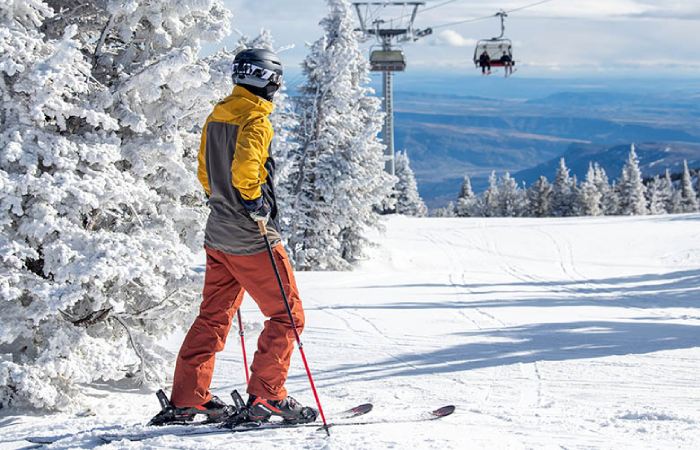As winter slants and the snow starts to blanket the mountains, it’s time to gear up for a thrilling ski season. Whether you’re a seasoned pro or a first-time skier, having the right equipment is crucial for a safe, enjoyable, and efficient experience on the slopes. In this guide, we’ll cover the essential ski gear that caters to all skill levels, ensuring you’re well-prepared for your winter adventures.
1. Skis

Choosing the Right Skis:
- Beginner Skis: If you’re new to skiing, opt for shorter skis with a softer flex. These skis are more forgiving and easier to operation, making them ideal for learning the basics and gaining confidence on the slopes.
- Intermediate Skis: As you progress, consider skis that offer a bit more stiffness and stability. All-mountain skis are a great choice for in-between skiers, providing versatility for various snow conditions and terrain.
- Advanced Skis: For advanced skiers, high-performance skis with specialized designs for carving, powder, or freestyle will enhance your skills. These skis offer precision, responsiveness, and superior handling for tackling challenging runs and conditions.
2. Ski Boots
The Importance of Proper Fit:
- Beginner Boots: Look for boots that offer comfort and ease of use. Soft flex boots are forgiving and provide a comfortable fit, allowing you to focus on learning without being hindered by discomfort.
- Intermediate Boots: At this stage, consider boots with a medium flex. They should offer a balance of comfort and performance, providing better control and responsiveness as you improve your technique.
- Advanced Boots: Advanced skiers need boots with a stiffer flex for greater precision and power transmission. Custom-fit boots are often recommended, as they offer a tailored fit that maximizes performance and comfort.
3. Ski Poles
Selecting the Right Poles:
- Beginner Poles: Adjustable poles are ideal for beginners, as they can be customized to the right length and easily adjusted as you grow more skilled. Look for lightweight materials to minimize fatigue.
- Intermediate and Advanced Poles: Fixed-length poles made from materials like aluminum or carbon fiber are suitable for intermediate to advanced skiers. These poles offer durability and precision, enhancing your skiing performance.
4. Ski Helmet
Safety First:
- Beginner Helmets: For beginners, a well-fitting helmet that meets safety standards is crucial. Look for helmets with adjustable ventilation to keep you comfortable in varying conditions.
- Intermediate and Advanced Helmets: Advanced skiers should consider helmets with additional features such as MIPS (Multi-directional Impact Protection System) technology, which offers enhanced protection against rotational forces during impacts. Features like audio compatibility and a snug, customizable fit can also add to your comfort and enjoyment.
5. Ski Goggles
Visibility and Protection:
- Beginner Goggles: Choose goggles with a wide field of vision and anti-fog features to ensure clear vision while learning. Substitutable lenses can be useful for adapting to changing light conditions.
- Intermediate and Advanced Goggles: Invest in high-quality goggles with polarized or photochromic lenses for superior vision in varying light conditions. Anti-scratch coatings and ventilation systems are essential for maintaining clear, fog-free vision.
6. Ski Clothing
Layering for Comfort:
- Base Layer: Start with moisture-wicking base layers to keep sweat away from your skin. Merino wool or synthetic fabrics work well to provide warmth without bulk.
- Mid Layer: A thermal mid-layer, such as a fleece or insulated jacket, adds an extra layer of warmth. Choose a mid-layer with good breathability to regulate your body temperature.
- Outer Layer: A waterproof and breathable ski jacket and pants are essential for protection against snow and wind. Look for features like adjustable cuffs, snow skirts, and vents to enhance comfort and functionality.
7. Ski Gloves and Socks
Keeping Warm and Comfortable:
- Gloves: Insulated, waterproof gloves or mittens are crucial for keeping your hands warm and dry. Consider gloves with armored palms and fingers for added durability.
- Socks: Opt for moisture-wicking, cushioned ski socks that fit well without bunching. Avoid cotton socks, as they can deception moisture and lead to cold feet.
8. Ski Backpack
Convenience on the Slopes:
- Beginner Backpacks: A small, lightweight backpack with enough space for essentials like water, snacks, and extra layers is ideal. Look for features like a hydration reservoir or easy-access pockets.
- Intermediate and Advanced Backpacks: For those who venture off-piste or need to carry additional gear, a larger backpack with features such as avalanche safety equipment, hydration systems, and additional storage compartments is beneficial.
Conclusion
With the right equipment, you can fully embrace the thrill of skiing at Nordic Valley Ski Resort while staying safe and comfortable. From ski equipment and boots to helmets and goggles, every piece of equipment is crucial for an optimal skiing experience. Investing in high-quality gear suited to your skill level ensures you’re prepared to conquer the slopes and enjoy your winter adventures to the fullest. So, gear up, hit the snow at Nordic Valley, and let the fun begin!

